The Fascinating History Behind The German-French Pizza Flammkuchen
There's a special magic to flat, doughy creations sprinkled with delicious, savory components. After all, traditional flatbread originated almost 30,000 years ago in Ancient Egypt and has evolved into a dizzying number of forms since. Production has continued into unique unleavened creations, like lavash, and puffy doughs with yeast, like the beloved pizza.
Another delicious rendition to add to the leavened repertoire is the German Flammkuchen, or French tarte flambée. The creation hails from the Alsace, a northeastern part of France with a heavy German influence, hence the crossover. Flammkuchen is thin-crusted and wood-fired, traditionally topped with lardons, fresh cheese, and onions.
The dish can be traced back to humble origins, first prepared by peasants around the Strasbourg area several hundred years ago. Invented by bakers, the high-heat crust likely emerged while waiting for a wood-burning oven to reach temperature. While crackling hot, scraps of bread dough would be rolled extremely thinly and baked to completion. Later, toppings were added, and the beloved dish became fully fleshed out. Innkeepers started selling Flammkuchen to the public in the 19th century, and it hasn't lost popularity since.
Flammkuchen places only a few ingredients on top of a leavened, thin-crust dough
Since Flammkuchen was originally made with leftover bread dough, it's a forgiving creation. The aim is a baked good that's crisp with an almost cracker-like consistency. Traditionally, yeast is included in the dough mixture, blended with flour, water, oil, and salt. Nowadays, recipes also substitute biscuit or pizza dough. Most critically, the dough is rolled out as thinly as possible. As a result, Flammkuchen leans more toward flatbread than pizza, without the sauce covering and dough thickness typical of American pizza styles.
The most classic topping trio is cheese, onions, and cured pork. The dairy component is fromage blanc, a soft and tart young cheese, which is mixed with easily made crème fraîche. The cheese goes atop the dough and is covered with thinly sliced onion slivers and lardons – French cured pork made without smoking. The creation goes into a scorching hot oven, ready in only a couple of minutes.
In addition to this popular combination, several other toppings are enjoyed, too. Some add gruyère or Munster for added cheesy notes or chopped mushrooms for another twist. Plus, there's even a dessert option crafted with apples. Like pizza, all the versions are made to be shared and enjoyed with friends and family alongside a glass of wine or beer.

